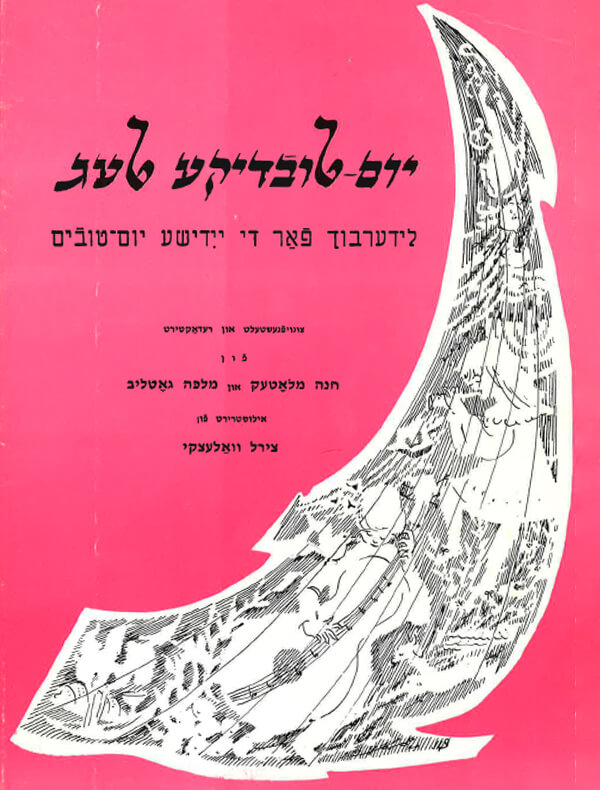
I have a little story for you,
a really fine story.
My father bought a kid
for two coins.
A little kid, a white one,
beatiful as gold
and two coins in cash
he paid for it
Khad gadyo!
There was a cat in the yard, of course,
a rascal, as is well known;
to devour that kid
was the cat’s desire.
The little dog noticed it
and it upset him greatly,
he threw himself on the wicked cat
and bit her in the neck.
Khad gadyo!
This angered the stick
and without thinking a thing
it split the little dog’s head–
You, dog, it’s none of your business!
Fire lit itself up
flaming red with anger:
You stick, you little pin,
I’ll make a corpse out of you.
Khad gadyo!
Kh’hob far aykh a maysele,
Amaysele gor sheyn.
Der tate hot a tsigele
Gekoyft far tsvey gildeyn.
A tsigele, a vaysinke,
A sheyninke vi gold,
Un tsvey gildeyn mezumene
Hot er far ir batsolt.
Khad gadyo!
Iz dokh in hoyf a kats geven,
A mazik, vi bavust;
Hot ketslen zikh fartsukn gor
Dos tsigele farglust.
Derzen hot es hintele,
Fardrist es im gants shtark,
Er varft zikh af der beyzer kats
Un bayst ir ayn in kark.
Khad gadyo!
Kumt shtekele in kas arayn
Un trakht gor nit keyn sakh,
Un shpalt dos kepl hintelen
Du, hunt, s’iz nit dayn zakh!
Tseflakert hot zikh fayerl
Far kas tsunter royt:
Du shtekele, du flekele,
Ikh makh dir bald a toyt.
Khad gadyo!
כ׳האָב פֿאַר אײַך אַ מעשׂהלע,
אַ מעשׂהלע גאָר שײן.
דער טאַטע האָט אַ ציגעלע
געקױפֿט פֿאַר צװײ גילדײן.
אַ ציגעלע, אַ װײַסינקע,
אַ שײנינקע װי גאָלד,
און צװײ גילדײן מזומענע
האָט ער פֿאַר איר באַצאָלט.
חד גדיא!
איז דאָך אין הױף אַ קאַץ געװען,
אַ מזיק, װי באַװוּסט;
האָט קעצלען זיך פֿאַרצוקן גאָר
דאָס ציגעלע פֿאַרגלוסט.
דערזען האָט עס הינטעלע,
פֿאַרדריסט עס אים גאַנץ שטאַרק,
ער װאַרפֿט זיך אױף דער בײזער קאַץ
און בײַסט איר אײַן אין קאַרק.
חד גדיא!
קומט שטעקעלע אין כּעס אַרײַן
און טראַכט גאָר ניט קײן סך,
און שפּאַלט דאָס קעפּל הינטעלען
דו, הונט, ס’איז ניט דײַן זאַך!
צעפֿלאַקערט האָט זיך פֿײַערל
פֿאַר כּעס צונטער רױט:
דו שטעקעלע, דו פֿלעקעלע,
איך מאַך דיר באַלד אַ טױט,
חד גדיא!
Song Title: Kh’ob Far Aykh A Maysele

Written by Chana Mlotek and her sister Malke Gottleib, Yontefdike Teg, a holiday songbook, was originally dedicated to Aaron Fishman, a beloved Yiddish educator, whose devotion to Yiddish culture inspired countless students who went on to become leaders in education and the arts. Because of Aaron Fishman’s long-term loyalty to the Yiddish shules (schools), the Yontefdike Teg collection was designed to serve the Yiddish shule and also to be an integral part of the Jewish home. The songs were chosen from material that was used in various types of Yiddish shules. Some of the songs even stem from the very beginning of the modern Yiddish shule in Europe and in America. In the collection, remarkable material can also be found, such as: songs sung in the Yiddish shules in Argentina; revived folksongs; adaptations from Avrom Goldfaden melodies; and new original music. The forty songs were chosen on the basis of first-hand experience of teaching Yiddish songs to children in the Yiddish shules and intentionally selected to be easily memorized and give great joy in singing.
The selection of the songs in this collection reflects the teaching practice in the modern Yiddish shule. There are more songs for the holidays of Chanukah, Purim and Pesach than for other holidays, largely because people are more likely to devote themselves to these holidays than to the others. Some songs represented a special significance for the editors. For example, the charming Khatsi-halayla (In the middle of the night) was chosen by the Arbeter Ring shules in Philadelphia, with which Aaron Fishman had close ties for many years. A second song, Shavuos, for which Aaron Bromberg (עייה), another teacher, had written the lyrics, has become a Chassidic tune that was taught by Leibush Lehrer, someone who had a very great universal influence. A notable innovation in this collection is that the songs are published in Yiddish, together with an English transliteration and an English summary for each song. Both the Yiddish and English transliterations conform to YIVO usage, the highest academic Yiddish language authority. The music is set in keys that are not difficult for young voices and that young fingers can easily play on the piano.
Those who have undertaken responsibility in the preparation of this collection are all active practitioners of Yiddish training, music and art. In addition, they all possess another underlying commonality: all were born in the United States, graduates of the Yiddish shules where, in several instances, they learned to sing the songs for the first time. They have all continued their interest and enthusiasm for the Yiddish shule. Not only have Yiddish songs enriched their private lives, but through these Yiddish songs, friends and family have developed love and respect for Yiddish music and Yiddish cultural works. In the original introduction, Mlotek and Gottleib write: It is our hope and aim that for Jewish children and their parents, the Jewish holidays in the shule and in the home will always be accompanied by Yiddish song and that Yiddish song will always help fortify the Jewish home and the Jewish holidays.